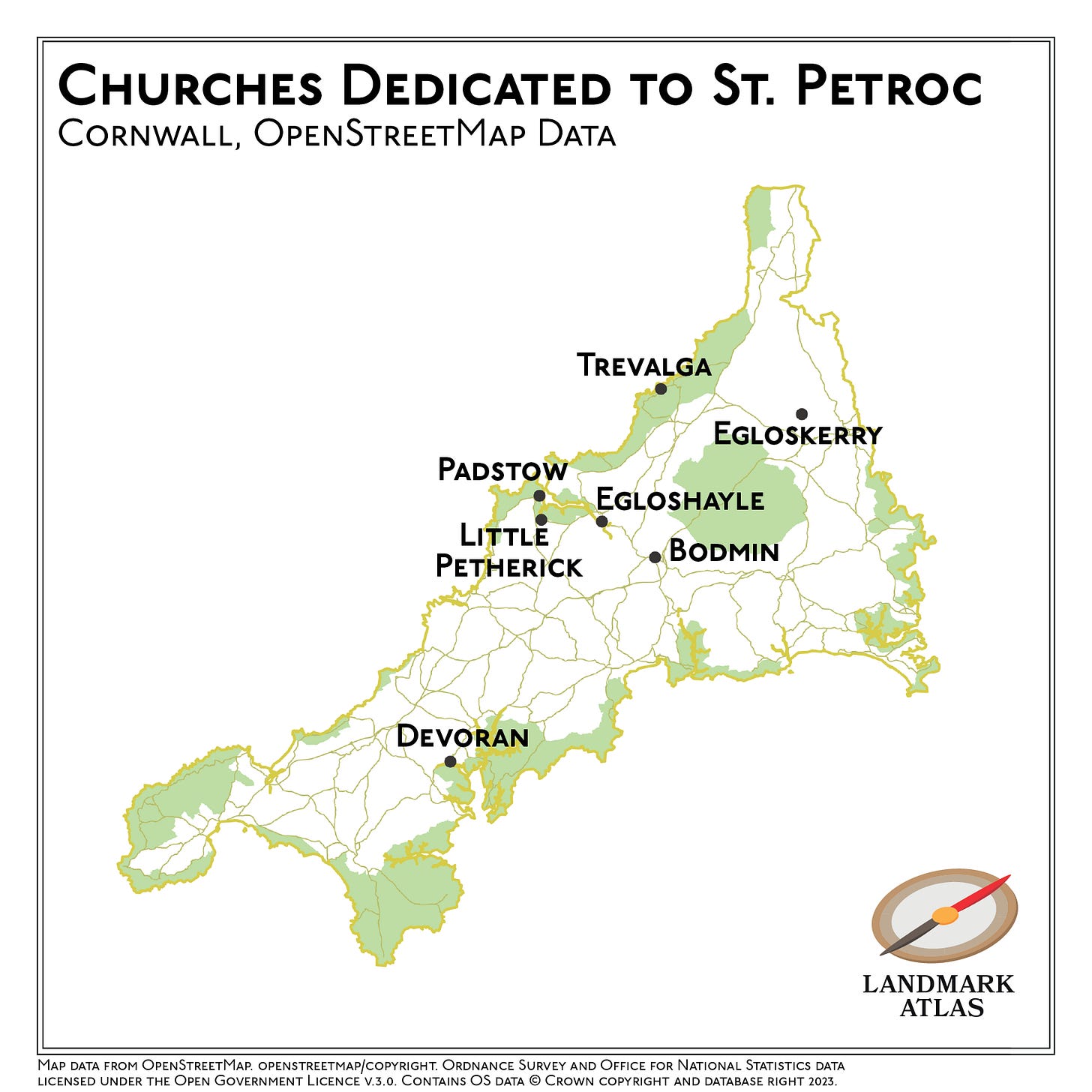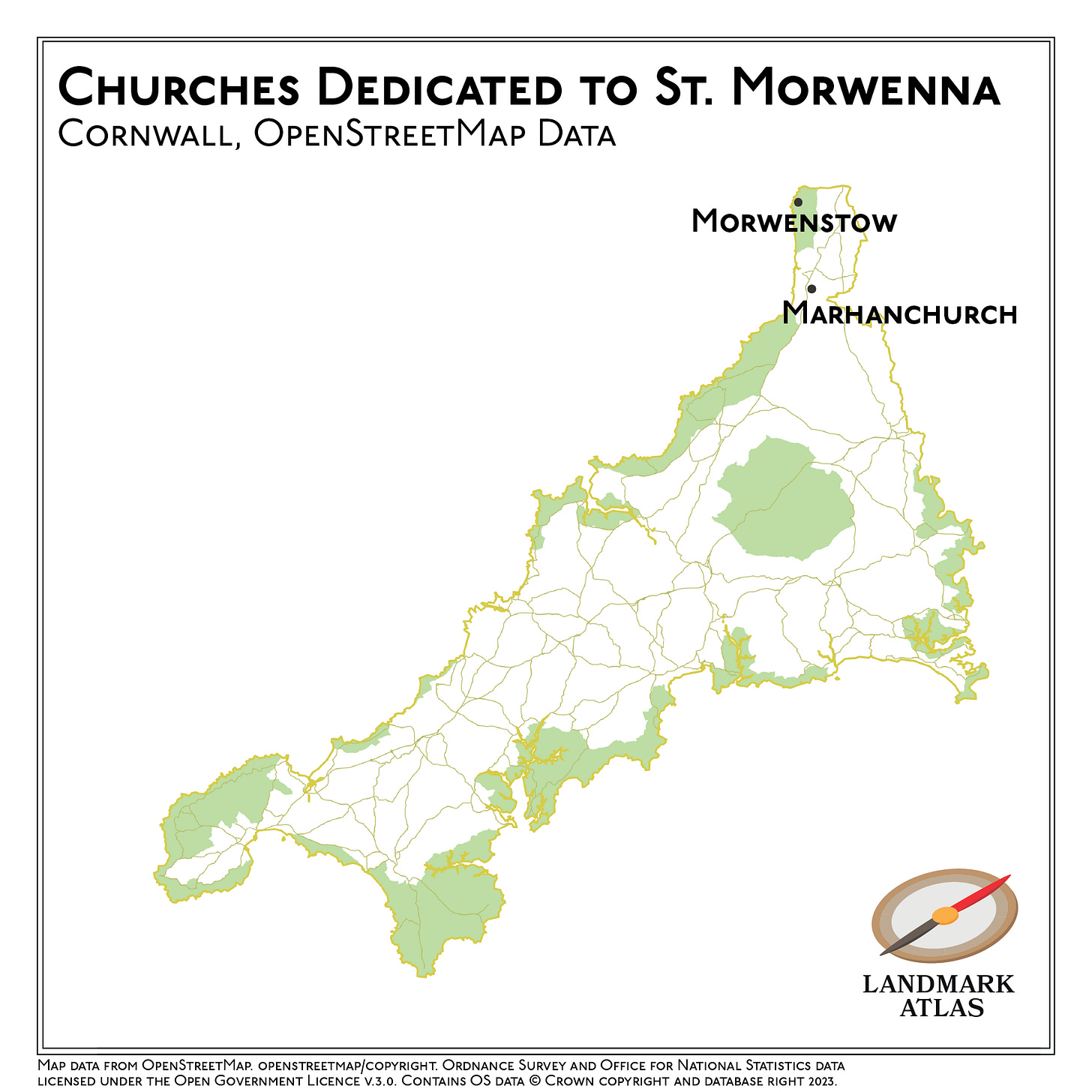Cornwall Venerates Its Own Saints
For All Saints Day, a look at how Cornish churches are dedicated to its Celtic saints

In the village of Crantock, near Newquay in northern Cornwall, lies St. Carantoc’s Church.
This Grade I listed church dates from the Norman times. That is old in itself, but Cornish people have worshipped on this site for much longer than that: since the 6th century, around the time of the life of St. Carantoc himself.
Carantoc was born into a royal family in west Wales but he eschewed his noble birth for an ascetic life. Like many of the Celtic saints, he appears to have travelled around between Wales, Ireland, Brittany (Crantock is twinned with a village there called Carantec) and Cornwall, founding monastic communities as he went.
According to one legend, he travelled across the Bristol Channel, arriving in England, but lost the altar he had taken with him. He asked King Arthur for help to retrieve it.
The story continues:
At that time Cato and Arthur were reigning in that country, dwelling in Dindrarthou; and Arthur came wandering round to find a serpent most fierce, huge and terrible, which had laid waste twelve parts of the land of Carrum, and Carantoc came and saluted Arthur, who rejoiced, and received a blessing from him. And Carantoc asked Arthur whether he had heard where his altar had come to shore; and Arthur replied, “If I am paid for it, I will tell thee;” and he said, “What dost thou ask to be done?” He answered, “That thou should'st take away the serpent that is close to thee, if thou art a servant of God, that we may see.” Then blessed Carantoc went and prayed to the Lord; and straightway the serpent came with great noise, like a calf running to its mother. And it bent its head before the servant of God like a servant obeying his master, with humble heart and downcast eyes. And he put his stole around its neck, and led it like a lamb…1
Carantoc refused to allow Cato to kill the dragon, instead allowing it to fly away with a command not to bother Arthur’s people again.
As far as I can tell, St. Carantoc’s at Crantock is the only church in England dedicated to this saint.
By my count he is one of 91 saints venerated in Cornish churches which have no other dedications anywhere else in England.
Saints venerated in England
England isn’t renowned as a country which treats saints with reverence.
After the Reformation the practice of venerating saints was discouraged and faded from English religious life. It was only during the Victorian era that the practice of dedicating churches to saints was revived. Often the original dedication of a church was unclear; attempts to deduce them from old records were often guesswork.
I analysed the names of churches in England from OpenStreetMap to discover the most popular saint dedications in the country.
The map above shows that St. Mary dominates the dedications of churches throughout the country. She is the most popular choice of saint in whose honour churches are named in every county except four. In Derbyshire, Lincolnshire and the East Riding of Yorkshire it is All Saints; while in Rutland, Saint Peter is the most popular.
This graphic shows the distribution of churches bearing the names of the 20 most popular saints in England.
Mary’s dominance is clear to see again here: churches dedicated to her can be found all over the country.
Other saints’ churches are distributed more unevenly. St. Margaret is popular in East Anglia, St. John the Baptist is popular in the Midlands and there is a cluster of St. Johns around Manchester and Lancashire.
Celtic Christianity in Cornwall
The Saxon invasion of Britain, which started after the Romans withdrew in the fifth century, pushed the Britons west into what was called Dunmonia (roughly equivalent to the West Country) and across the English Channel into Armorica (modern Brittany).
Cornwall was further isolated after the establishment of the Kingdom of Wessex in 519; the Cornish had more in common linguistically and culturally with the Bretons of Armorica than with the Saxons of what became England at this time. Part of Brittany used to be called Cornouaille, which is still used today in French to refer to Cornwall.
Wales and Ireland contributed more missionary saints than Cornwall during the fifth and sixth centuries. These men travelled between the different Celtic lands founding monasteries and preaching2.
These include two of Cornwall’s most famous saints: St. Piran and St. Petroc.
St. Piran
St. Piran is generally regarded as the patron saint of Cornwall. His white cross on a black background is the national flag of the county.
His Cornish name Perran gives his name to several of the towns where churches are dedicated to him: Perrannuthnoe, Perranarworthal and Perranzabuloe. He died in the year 480.
St. Petroc
Several of the Cornish towns with churches named after St. Petroc feature in his Oxford Dictionary of Saints entry.
They include Padstow (Petroc’s Stow); Little Petherick, where he founded a monastery and Bodmin, where he lived as a hermit on the moor.
His relics were transferred from Padstow to Bodmin. In 1177 they were stolen and taken to Saint-Meén in Brittany. This was a matter serious enough for the Bishop of Exeter to alert Henry II. A compromise was eventually arranged whereby Petroc’s rib would remain in Brittany and the rest of his relics would return to Bodmin.
His fine reliquary survived the iconoclasm that swept across England during the Reformation and is still in St Petroc’s, Bodmin.
St. Morwenna
According to the stories she was one of the many children of St. Brychan (the most common number given is 24).
The Oxford Dictionary of Saints entry for Morwenna states:
Legend related that when the people built a church, Morwenna carried a stone on her head up from beneath the cliff; when she put it down to rest, St Morwenna’s well sprang up; when she finally deposited it at the place where she wanted, the church was built there, although the first choice for its site was elsewhere.3
Both of her churches are in villages also named after her: Morwenstow and Marhamchurch.
At least three saints who were supposedly her siblings - Clether, Endellion and Nectan - also have churches dedicated to them in Cornwall.
As discussed earlier, many of the saints that have come to be venerated in Cornwall came from Wales and Ireland as opposed to Saxon England.
This means that although Cornish saints are often unique in England, this is not always the case for Wales.
At the beginning of this post we met St. Carantoc. In Wales he is known as Carranog. Here he is in his native Ceredigion gazing out over the bay of Llangrannog.
If you liked this post, you’ll probably like Paul Kingsnorth’s Fifty Holy Wells series.
Caveats
The data on church names comes from OpenStreetMap (OSM). I am grateful to OSM contributors for compiling the data and for the organisation for making their data available. However, it’s not a definitive source.
I made an extensive effort to clean the data and remove errors but it’s likely some may have crept through, or that some churches may not be marked in the first place.
I wasn’t helped by the fact that some saints, especially the Celtic and old Saxon ones, go by multiple names. For example, St. Alphege, a former Archbishop of Canterbury, was also known as Alphage or Alfege.
Some churches have more than one dedication. I counted these churches twice where appropriate. This means that a church dedicated to St. Peter and St. Paul would be counted under both saints’ names.
G.H. Doble, Cornish Saints Series
Thomas Taylor, The Celtic Christianity of Cornwall
David Farmer, The Oxford Dictionary of Saints










